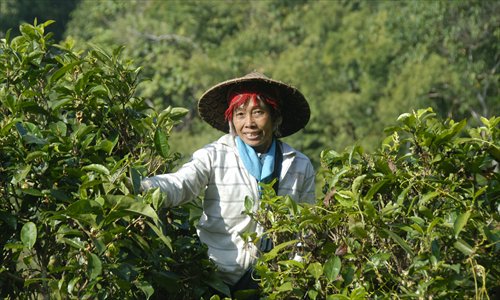Above the Clouds
An exploration of Lao tea traditions

A tea picker picks tea leaves in Phongsaly, Laos. Photo: IC
Mr Seungkham, a gentle faced Yao gentleman, opened a sack behind his chair.
As the late morning sun slanted though the bamboo walls, he put his nose to the opening and inhaled deeply, his eyes closed in concentration.
A small twitch gave hint to his judgement, so he chose another. He inhaled again.
An almost imperceptible smile let me know the contents met his standards.
Taking a handful of the curled dry leaves and putting them aside, he then reached under a foldable table and pulled out a sealed plastic box and a bamboo tray.
Gently, and with great reverence, he lifted out two lidded bowls delicately decorated with peonies, a number of delicate glass cups, along with what looked to my medical trained eyes to be medical forceps, and used them to distribute the glass bowls around the tray.
From a battered thermos steaming water was washed over the leaves he'd transferred to a lidded pot. The delicacy with which he handled the tea and accoutrements was almost, but not quite, out of place in this dirt floored village.
Old men sat in silence on very low stools, some smoking a bamboo pipe, but my eyes were glued on the Yao tea ceremony.
Seukham opened the bowl again, lifting the lid to his nose. With eyes closed, he inhaled the aroma of the newly steeped leaves.
Smiling he poured the elixir into the tiny glass cups immediately emptying the pale yellow liquid in them onto the deeply etched bamboo tray.
Refilling the tea bowls he gave a very subtle inclination of his head, indicating that we could drink this time.
The tea was alive, grassy, tangy almost sharp but warming, and I wanted more. Later he repeated the same ritual with tea a year older.
Age had lent the tea depth and generosity. It tasted of the forest and the stony ground from which it had come.
It had gravitas. These, he said, were from ancient wild tea trees, which we were welcome to visit.
Collecting the wild tea in Phongsaly, Laos, we were warned, usually takes six hours of rigorous walking, or a precipitous wild ride across the mountain face on a track at times only half a meter wide, then a knee deep river walk and a steep ascent.
Fire had almost killed the trees, he explained. The ancient trunks had been coppiced, but as we visited the wild tea stands, Chinese companies were burning vast tracts of adjacent hillsides for bananas and maize, both cheap exports, putting wild and ancient tea plantations at risk.
Around us, the mountain forest was on fire. Fires in the primary and secondary forests, appeared to be unconstrained. Losing the tea trees would be a disaster for all parties, as they are dependent on the income from tea to buy basic food supplies.
Crossing borders
It's impossible to know just how much tea is exported from Phongsaly, as many informal paths through the mountains allow tea buyers to avoid duties or taxes.
Before leaving Phongsaly, we met a Lao customs inspector who denied than any such trade occurred. "No, we have no problem," he insisted.
The tea they bring back from these arduous conditions, fetches between 300,000 -900,000 kip ($38-110) per kilo. This year the price dropped.
They are beholden to China-based buyers to determine the price, while the work needed to bring in the harvest remains the same.
The tea is raised organically, protected by government regulations. While pesticides are in evidence on Chinese agricultural projects, elsewhere the Lao tea remains as pure as the mountain air.
Older Chinese are well informed about the origins of tea; a drink so revered, it is integral to Chinese hospitality and rituals.
Genetically traced to Yunnan Province, the evergreen camellia sinensis, whose fresh and processed leaves make tea enjoyed globally, eventually spread; in this case to Laos where they eat pickled tea leaves, known as mien.
Lao's proximity to Yunnan makes it evolutionarily unremarkable that Lao also became a tea growing center. The tea village of Ban Komaen produces what connoisseurs say is very good Pu'er tea. Old Lao tea is sold in China as yiwu tea - and some tea labelled as "Made in China" is actually grown, processed and packaged in Lao.
This maybe because tea fraud is so rampant that customers trust only "China made" tea. This means Lao does not get the credit for its excellent, hard won and organically grown crop.
Later at Sayloum village I drank Sa bang tea as the village head's cat, its back to the still smoking fire, snoozed. At 58 the smiling woman still processes her own tea. It is that personal touch that makes Lao tea special.
Lao made red (black) tea has been compared favorably to Fujian tea, crossed with the maltiness of a good Assam. Sa bang tea, processed in bamboo tubes and rolled like cigars, has gained an international reputation.
We visited tea processing plants in Phongsaly, one owned by Chinese nationals and the other by Lao. The Chinese processing plant "Land Sun" was largely mechanized and no Lao employees were apparent.
My Chinese speaking interpreter told me their packages said "Made in China." In contrast, the Lao plant was buzzing with chatter, old women sitting around tables, their eagle eyes looking for poorly dried leaves, twigs, anything that might spoil the tea's taste. We sat drinking fragrant tea until the afternoon fell away.